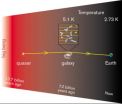(Press-News.org) The amount of rainfall and number of tropical storms during the summer monsoon season greatly impact the agriculture, economy, and people in Asia. Though meteorologists and climate scientists have worked for years to develop helpful prediction systems, seasonal predictions of these two types of weather phenomena are still poor. Scientists working at the International Pacific Research Center, University of Hawaii at Manoa, have now made a promising breakthrough for predicting in spring both the summer monsoon rainfall over East Asia and the number of tropical storms affecting East Asian coastal areas. The study is published in the January 21, 2013, Proceedings of the National Academy of Sciences.
The scientists have shown that both the East Asian summer monsoon and the storm activity in the western North Pacific are controlled by fluctuations in the western Pacific Subtropical High (WPSH), a major atmospheric circulation system in the global subtropics centered over the Philippine Sea. When this system is strong in summer, then monsoon rainfall tends to be greater than normal over East Asia, and in the western North Pacific there tend to be fewer tropical storms that make landfall.
With the help of computer modeling experiments, the scientists found that these summer fluctuations in the WPSH are more than 65% predictable in spring. When the Indo-Pacific warm pool shows a dipolar sea surface temperature anomaly (that is, an unusually warm Indian Ocean together with an unusually cool western North Pacific) or the central Pacific tends to cool in spring, then the WPSH will be strong and stable with ensuing greater summer monsoon rainfall over the East Asian monsoon front and the Ganges River Valley in India, but fewer tropical storms will affect East Asian coastal areas and the western subtropical Pacific. The team traced the rainfall and storm variability in the Asian monsoon region to the feedback occurring between the WPSH and the underlying Indo-Pacific warm-pool ocean.
"Our findings create a promising way for predicting monsoon rainfall and tropical storm days during the East Asian summer," concludes lead author Bin Wang, meteorology professor at the University of Hawaii at Manoa and faculty at the International Pacific Research Center. "As a first step, we use global general circulation models to predict the fluctuations in the WPSH, and then in a second step, we use this forecast to predict rainfall and storm days in regional analyses. We have done hindcasts from 1979 to 2009 using this approach and have found substantially improved skills over the use of dynamical climate models in predicting the East Asian Summer Monsoon rainfall and tropical storm activity."
INFORMATION:
This work was supported by the Global Research Laboratory Program, Korean Ministry of Education, Science and Technology Grant 2011-0021927; National Science Foundation Award AGS-1005599, an Asia-Pacific Economic Cooperation Climate Center international project; and by the institutional support of the International Pacific Research Center (JAMSTEC, NASA, and NOAA)
Citation: Wang, B., B. Xiang, and J.-Y. Lee: Subtropical High predictability establishes a promising way for monsoon and tropical storm predictions. PNAS 10.1073/pnas.1212646110
Researcher Contact: Bin Wang, tel.: (808) 956-2563, email: wangbin@hawaii.edu
International Pacific Research Center Media Contact: Gisela E. Speidel, tel.: (808) 956-9252, email: gspeidel@hawaii.edu.
The International Pacific Research Center (IPRC) of the School of Ocean and Earth Science and Technology (SOEST), University of Hawaii at Manoa, is a climate research center founded to gain greater understanding of the climate system and the nature and causes of climate variation in the Asia-Pacific region and how global climate changes may affect the region. Established under the "U.S.-Japan Common Agenda for Cooperation in Global Perspective" in October 1997, the IPRC is a collaborative effort between agencies in Japan and the United States.
Prediction of Asian summer monsoon rainfall and tropical storm activity close at hand
2013-01-23
ELSE PRESS RELEASES FROM THIS DATE:
Residents near Chinese e-waste site face greater cancer risk
2013-01-23
CORVALLIS, Ore. – Residents living near an e-waste recycling site in China face elevated risks of lung cancer, according to a recent study co-authored by Oregon State University researchers.
Electronic trash, such as cell phones, computers and TVs, is often collected in dumps in developing countries and crudely incinerated to recover precious metals, including silver, gold, palladium and copper. The process is often primitive, releasing fumes with a range of toxic substances, including polycyclic aromatic hydrocarbons, or PAHs, a group of more than 100 chemicals.
PAHs, ...
Plants adapt to drought but limits are looming, study finds
2013-01-23
Scientists with the U.S. Department of Agriculture, or USDA, and their partners have determined that water demand by many plant communities can fluctuate in response to water availability, indicating a capacity for resilience even when changing climate patterns produce periodic droughts or floods.
But their research also suggests that a limit to this resilience ultimately could threaten the survival of these plant communities. Sensitive environments such as the arid grasslands in the Southwestern U.S. already are approaching this limit.
Results from this study were published ...
Immune cell death defects linked to autoimmune diseases
2013-01-23
Melbourne researchers have discovered that the death of immune system cells is an important safeguard against the development of diseases such as type 1 diabetes, rheumatoid arthritis and lupus, which occur when the immune system attacks the body's own tissues.
The finding suggests that these so-called autoimmune diseases could be treated with existing medications that force long-lived immune system cells to die.
In the development of the immune system, some cells are produced that have the potential to attack the body's own tissues, causing autoimmune disease. The death ...
CSIRO telescope takes temperature of Universe
2013-01-23
Astronomers using a CSIRO radio telescope have taken the Universe's temperature, and have found that it has cooled down just the way the Big Bang theory predicts.
Using the CSIRO Australia Telescope Compact Array near Narrabri, NSW, an international team from Sweden, France, Germany and Australia has measured how warm the Universe was when it was half its current age.
"This is the most precise measurement ever made of how the Universe has cooled down during its 13.77 billion year history," said Dr Robert Braun, Chief Scientist at CSIRO Astronomy and Space Science.
Because ...
Studies provide insights into inherited causes of autism
2013-01-23
The most consistent finding of autism research lies in the revelation that the disorders are incredibly complex. Two new studies in the January 23 issue of the Cell Press journal Neuron that add to the growing appreciation of this complexity focus on identifying inherited genetic mutations linked with autism spectrum disorders. The mutations—which are distinct from the spontaneous mutations that have been the focus of previous studies—may provide valuable insights into the causes of autism.
"It's long been known that autism is a heritable condition and that some cases ...
New brain circuit sheds light on development of voluntary movements
2013-01-23
DURHAM, N.C. – All parents know the infant milestones: turning over, learning to crawl, standing, and taking that first unassisted step. Achieving each accomplishment presumably requires the formation of new connections among subsets of the billions of nerve cells in the infant's brain. But how, when and where those connections form has been a mystery.
Now researchers at Duke Medicine have begun to find answers. In a study reported Jan. 23, 2013, in the scientific journal Neuron, the research team describes the entire network of brain cells that are connected to specific ...
Whole-exome sequencing identifies inherited mutations in autism
2013-01-23
Boston, Mass. - While autism clearly runs in some families, few inherited genetic causes have been found. A major reason is that these causes are so varied that it's hard to find enough people with a given mutation to establish a clear pattern. Researchers at Boston Children's Hospital have pinpointed several inherited mutations—among the first to be identified—through an unusual approach: using whole-exome sequencing to study large Middle Eastern families with autism.
The study, published in the January 23 issue of the journal Neuron, also found evidence for some of ...
Setting the dark on fire
2013-01-23
In space, dense clouds of cosmic gas and dust are the birthplaces of new stars. In visible light, this dust is dark and obscuring, hiding the stars behind it. So much so that, when astronomer William Herschel observed one such cloud in the constellation of Scorpius in 1774, he thought it was a region empty of stars and is said to have exclaimed, "Truly there is a hole in the sky here!" [1]
In order to better understand star formation, astronomers need telescopes that can observe at longer wavelengths, such as the submillimetre range, in which the dark dust grains shine ...
Researchers design a new imaging technique for identifying the age and sex of a corpse
2013-01-23
Researchers at the University of Granada, Spain, have designed a new computing system that determines the age and sex of a corpse with a reliability of 95%. This system is based on free software called Image and a free DICOM displayer called K-Pacs. This state-of-the-art system is very different from the traditional macroscopy systems used to evaluate the osteoarticular features of a corpse, and it is much faster and user-friendly.
The author of this study is Manuel López Alcaraz, a researcher at the Forensic Anthropology Laboratory of the University of Granada, in collaboration ...
Astrocytes identified as target for new depression therapy
2013-01-23
BOSTON (January 23, 2013) — Neuroscience researchers from Tufts University have found that our star-shaped brain cells, called astrocytes, may be responsible for the rapid improvement in mood in depressed patients after acute sleep deprivation. This in vivo study, published in the current issue of Translational Psychiatry, identified how astrocytes regulate a neurotransmitter involved in sleep. The researchers report that the findings may help lead to the development of effective and fast-acting drugs to treat depression, particularly in psychiatric emergencies.
Drugs ...





